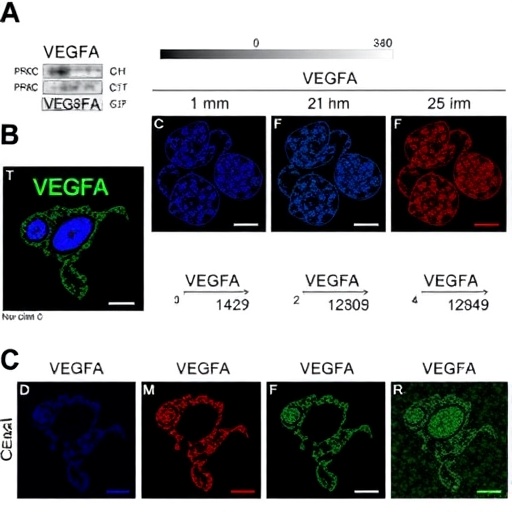
In a groundbreaking study recently published in the Journal of Translational Medicine, researchers led by Che, X., Zhang, C., and Zhuo, Y. have unveiled a significant breakthrough in the field of osteoarthritis (OA) diagnosis and assessment. This innovative research highlights serum Thrombospondin-1 (TSP-1) as a promising biomarker that may change the future landscape of how osteoarthritis is understood, diagnosed, and classified. With the rising incidence of OA globally, this finding is poised to offer new insights and opportunities for early intervention and treatment strategies that can ameliorate patient outcomes.
Osteoarthritis is a degenerative joint disease characterized by the deterioration of cartilage, leading to pain, stiffness, and decreased mobility. It affects millions worldwide and is a leading cause of disability. Traditionally, the diagnosis of OA has relied heavily on clinical evaluations and imaging techniques, which often overlook the molecular and genetic complexities of the disease. In their novel research, the authors emphasize the urgent need for advanced biomarkers to enhance early disease detection and severity assessment, thereby allowing for timely therapeutic interventions.
The researchers meticulously investigated the levels of serum TSP-1 among various cohorts of participants, some of whom were diagnosed with OA and others who were considered healthy controls. Their study revealed a compelling correlation between elevated serum TSP-1 levels and the severity of osteoarthritis, indicating that TSP-1 can be employed as a potential quantitative measure of disease progression. This correlation opens doors to a new diagnostic pathway that could significantly improve clinical decision-making processes.
TSP-1 is a multifunctional glycoprotein that plays a crucial role in cell-to-cell and cell-to-matrix interactions, and it has garnered attention in several pathological processes beyond osteoarthritis, including cancer and cardiovascular diseases. This study focuses specifically on the implications of TSP-1 in osteoarthritis, emphasizing its potential role in articulating the biological underpinnings that contribute to the disease’s progression. By unraveling the mechanical profiles of TSP-1, the authors point toward potential therapeutic targets that go beyond symptomatic relief.
In this comprehensive investigation, the authors utilized advanced statistical analyses and biomarkers profiling to substantiate their findings. The quantitative assessment of TSP-1 levels was pivotal in delineating its diagnostic potential in distinguishing between various stages of osteoarthritis. The clinical implications are profound; employing serum TSP-1 in routine evaluations could lead to earlier detection of the disease, ultimately translating into improved patient outcomes through more proactive management strategies.
Moreover, the research presents TSP-1 as not just a diagnostic biomarker, but a potential therapeutic target for the treatment of osteoarthritis. By understanding the pathways through which TSP-1 operates, researchers and clinicians may develop novel treatment modalities aimed at modifying the disease course rather than merely alleviating symptoms. This approach could pave the way for disease-modifying osteoarthritis drugs (DMOADs) that act specifically by targeting the underlying molecular mechanisms driving osteoarthritis progression.
The implications of this study extend beyond individual patient care. With the burgeoning global population, the economic burden of osteoarthritis continues to rise, necessitating new paradigms in healthcare delivery. The ability to assess disease severity accurately and early can help allocate resources more effectively, streamline treatment protocols, and ultimately enhance the quality of life for millions of individuals affected by this debilitating condition. As the scientific community continues to grapple with the challenges posed by osteoarthritis, TSP-1 emerges as a ray of hope that may usher in a new era of precision medicine for OA patients.
The significance of this research cannot be overstated; the authors not only provide compelling evidence of TSP-1’s utility in the clinical setting but also encourage future studies to explore its use in other musculoskeletal disorders. As the understanding of molecular biomarkers evolves, the potential for innovative treatment approaches expands, offering new avenues for interdisciplinary collaboration between researchers, clinicians, and pharmaceutical developers. This collaborative spirit will be essential in advancing the science of osteoarthritis and providing new solutions for patients worldwide.
In conclusion, the identification of serum TSP-1 as a crucial biomarker for osteoarthritis severity assessment and diagnosis marks a pivotal advancement in osteoarthritis research. The innovative findings from Che, X., Zhang, C., Zhuo, Y., and their team hold promise for transforming the clinical landscape of osteoarthritis, offering hope for early detection, improved management strategies, and ultimately enhanced patient care. The future of osteoarthritis treatment may very well hinge on the insights provided by this compelling research, underscoring the importance of continued exploration and innovation in the realm of musculoskeletal health.
As this study inspires further investigation and clinical use, healthcare practitioners and researchers alike must remain vigilant in seeking out additional biomarkers that can contribute to a more nuanced understanding of osteoarthritis. The interdisciplinary efforts that build upon the findings of this promising research could lead to even greater strides in the diagnosis and management of osteoarthritis, benefitting countless individuals who are grappling with this widespread condition.
The journey toward a more refined and scientifically informed approach to osteoarthritis management is just beginning, and with the introduction of TSP-1 as a pivotal player in this narrative, the potential for significant advancements in patient care and quality of life has never been brighter. As we pave the way for the next generation of osteoarthritis research and treatment, collaboration, innovation, and a patient-centered mindset will be vital in overcoming the challenges posed by this complex and pervasive disease.
Certainly, as scientists continue to investigate the implications of TSP-1 and other biomarkers, the field of osteoarthritis research stands at the precipice of unprecedented developments that may reshape our understanding of the disease for decades to come. The urgency of addressing osteoarthritis—a condition that affects a substantial segment of the global population—remains paramount, and insights such as those derived from the study on serum TSP-1 will be indispensable in meeting this challenge head-on.
Subject of Research: Serum TSP-1 as a biomarker for osteoarthritis diagnosis and severity assessment.
Article Title: Serum TSP-1 is a useful biomarker in severity assessment and the diagnosis of osteoarthritis.
Article References:
Che, X., Zhang, C., Zhuo, Y. et al. Serum TSP-1 is a useful biomarker in severity assessment and the diagnosis of osteoarthritis.
J Transl Med 23, 987 (2025). https://doi.org/10.1186/s12967-025-07022-z
Image Credits: AI Generated
DOI: 10.1186/s12967-025-07022-z
Keywords: Osteoarthritis, biomarker, TSP-1, diagnosis, severity assessment.
Tags: advanced biomarkers for OAcartilage deterioration and mobilityclinical evaluations for OA diagnosisdegenerative joint disease researchearly intervention strategies for osteoarthritisJournal of Translational Medicine studymolecular assessment of osteoarthritisnew insights into osteoarthritis treatmentosteoarthritis diagnosis breakthroughrising incidence of osteoarthritis globallyserum Thrombospondin-1 biomarkerseverity assessment in osteoarthritis




